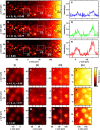Light-sheet microscopy with attenuation-compensated propagation-invariant beams
- PMID: 29740614
- PMCID: PMC5938225
- DOI: 10.1126/sciadv.aar4817
Light-sheet microscopy with attenuation-compensated propagation-invariant beams
Abstract
Scattering and absorption limit the penetration of optical fields into tissue. We demonstrate a new approach for increased depth penetration in light-sheet microscopy: attenuation-compensation of the light field. This tailors an exponential intensity increase along the illuminating propagation-invariant field, enabling the redistribution of intensity strategically within a sample to maximize signal and minimize irradiation. A key attribute of this method is that only minimal knowledge of the specimen transmission properties is required. We numerically quantify the imaging capabilities of attenuation-compensated Airy and Bessel light sheets, showing that increased depth penetration is gained without compromising any other beam attributes. This powerful yet straightforward concept, combined with the self-healing properties of the propagation-invariant field, improves the contrast-to-noise ratio of light-sheet microscopy up to eightfold across the entire field of view in thick biological specimens. This improvement can significantly increase the imaging capabilities of light-sheet microscopy techniques using Airy, Bessel, and other propagation-invariant beam types, paving the way for widespread uptake by the biomedical community.
Figures






References
-
- Huisken J., Swoger J., Del Bene F., Wittbrodt J., Stelzer E. H. K., Optical sectioning deep inside live embryos by selective plane illumination microscopy. Science 305, 1007–1009 (2004). - PubMed
-
- Höckendorf B., Thumberger T., Wittbrodt J., Quantitative analysis of embryogenesis: A perspective for light sheet microscopy. Dev. Cell 23, 1111–1120 (2012). - PubMed
-
- Ahrens M. B., Orger M. B., Robson D. N., Li J. M., Keller P. J., Whole-brain functional imaging at cellular resolution using light-sheet microscopy. Nat. Methods 10, 413–420 (2013). - PubMed
-
- Swoger J., Verveer P., Greger K., Huisken J., Stelzer E. H. K., Multi-view image fusion improves resolution in three-dimensional microscopy. Opt. Express 15, 8029–8042 (2007). - PubMed
Publication types
LinkOut - more resources
Full Text Sources
Other Literature Sources

